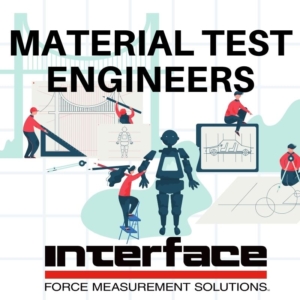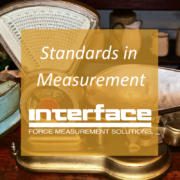Interface Solutions for Material Testing Engineers
 Force measurement inherently is part of all types of engineering throughout the entire development process of products, structures, consumer goods, and the materials used to construct them.
Force measurement inherently is part of all types of engineering throughout the entire development process of products, structures, consumer goods, and the materials used to construct them.
In the beginning of the design and development processes, material testing engineers utilize sensor technologies and instrumentation to measure the durability, fatigue, safety, and quality of the materials used for their projects.
The role of a materials engineer is to develop, process, combine, and test materials to be used in production. Based on data gathered, combined with their expertise, the materials engineer will identify and recommend the appropriate materials for specific applications. Ultimately, they are the foundation of product development because it is their responsibility to select materials based on the use of the product, its ability to perform its task and function, and durability of materials to hold up over time. They also test for environmental impact and exposure considerations.
Five Categories of Material Testing
- Mechanical testing
- Testing for thermal properties
- Testing for electrical properties
- Testing for resistance to corrosion, radiation, and biological deterioration
- Nondestructive testing (NDT)
Force measurement is most often used is in the material testing category of mechanical testing. This applies to testing materials used in all types of industries, including infrastructure, aerospace, automotive, industrial automation, manufacturing of consumer goods and in the machines used to assemble products. In mechanical testing, Interface sensors are commonly used to conduct:
- Hardness Testing
- Tensile Testing
- Impact Testing
- Fracture Toughness Testing
- Creep Testing
- Fatigue Testing
- Nondestructive Testing
Interface Material Test Engineer Solutions
Material testing has been around since the first invention, to determine quality, durability and resilience of products and parts. What has changed over the centuries and decades is the sophistication of force testing and measurement. Interface’s robust line of load cells, torque transducers, multi-axis sensors, and instrumentation are used in about every industry for material testing. If it must be measured, Interface has a solution.
Interface’s force measurement products are being used to gather data from testing materials in applications used for industrial automation, structures, medical devices, vehicles on the ground and in the air, packaging, sports equipment and more. Material testing engineers ensure reliability and safety of the chosen materials. Here are examples of how material testing engineers use our products.
Tensile Testing of 3D Printing Materials
Interface was contacted by a test engineering team in search of a solution for conducting a tensile force test on different 3D printing materials until failure. They wanted to test several types of material types. The 3D printing materials to be tested to see how it performed included PLA, PETG and ASA. The test of the materials was to assess strength, quality, ductility, and stiffness. Interface supplied our most popular load cell, the 1200 Standard Precision LowProfile™ Load Cell, to install into the engineer’s test frame. The tensile test gathered the force results from the load cell that was synced through Interface’s instrumentation solution, the INF-USB3 Universal Serial Bus Single Channel PC Interface Module. The results were displayed on their computer with supplied software from Interface. Read more about this material testing application solution here.
 Bike Frame Fatigue Testing
Bike Frame Fatigue Testing
Fatigue testing is a critical material test used to ensure the materials used in a product hold up over time. A bike manufacturing company wanted to perform a fatigue test on their bike frames to analyze the strength of their frames, ensure durability and high-quality standards. Interface suggests installing Model 1000 Fatigue-Rated LowProfile™ Load Cell to the customer’s bike frame fatigue tester. This load cell will provide the customer highly accurate results through the fatigue cycling. Results are collected using the INF-USB3 Universal Serial Bus Single Channel PC Interface Module and displayed on the customer’s computer with Interface’s provided software. The bike manufacturing company successfully had their bikes undergo fatigue frame testing, receiving highly accurate results with Interface’s load cell and instrumentation. Watch the fatigue testing of the bike frame in this animated app note.
Spring Compression Testing
A customer wanted to evaluate the performance of their springs, but also the functionality of their spring test stand with a wireless solution. Interface suggested using one of their WTS-5200XYZ 3-Axis Force Moment Load Cell which has three integral WTSAM-1E Wireless Transmitters and installing it into the customer’s spring compression frame. The WTS-5200XYZ 3-Axis Force Moment Load Cell measured the force compression of the spring. The integral WTS-AM-1E Wireless Strain Bridge Transmitter Modules transmitted and displayed the information wirelessly to the LCCAXXX Wireless Instrument Enclosure. Using Interface’s solution, the customer was able to wirelessly get compression results on the spring being tested. They were also able to verify their spring compression test stand was working effectively.
Selecting the right material is critical to product develop and material testing engineers rely on Interface due to the accuracy and reliability of our solutions. If you have questions on what products are best suited for your material testing applications, please contact us.
ADDITIONAL RESOURCES
Tensile Testing for 3D Materials
Furniture Fatigue Cycle Testing
Bike Handlebar Fatigue Testing App Note
Aircraft Wing Fatigue App Note








